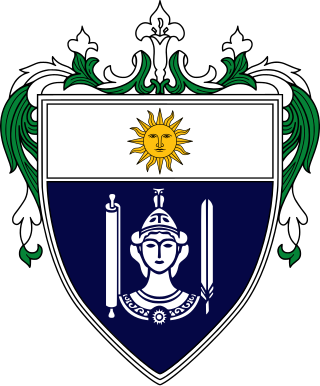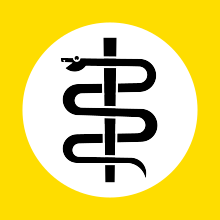
The University of Santo Tomas, officially the Pontifical and Royal University of Santo Tomas, Manila or colloquially as Ustê, is a private Catholic research university in Manila, Philippines. Founded on April 28, 1611, by Spanish friar Miguel de Benavides, third Archbishop of Manila, it has the oldest extant university charter in Asia and is one of the world's largest Catholic universities in terms of enrollment found on one campus. It is the main campus of the University of Santo Tomas System that is run by the Order of Preachers.

The University of the Philippines Manila is a public, coeducational, research university located in Ermita, Manila, Philippines. It is known for being the country's center of excellence in the health sciences, including health professional education, training, and research. It is the oldest of eight constituent universities of the University of the Philippines System, and predates the founding of UP by three years. It was originally established on December 1, 1905, as the Philippine Medical School and later renamed as the UP College of Medicine and Surgery on June 10, 1907. In 1983 it was renamed as University of the Philippines Manila.
The University of Santo Tomas Faculty of Engineering, or UST-Eng, is the engineering school of the University of Santo Tomas, the oldest and the largest Catholic university in Manila, Philippines.

The University of Santo Tomas Faculty of Arts and Letters, popularly known as "UST Artlets" or "UST AB", is the liberal arts school of the University of Santo Tomas, the oldest and the largest Catholic university in Manila, Philippines.

The University of the Philippines Manila College of Medicine (CM) is the medical school of the University of the Philippines Manila, the oldest constituent university of the University of the Philippines System. Its establishment in 1905 antedates the foundation of the UP System and makes it one of the oldest medical schools in the country. The Philippine General Hospital, the national university hospital, serves as its teaching hospital.
The University of Santo Tomas Faculty of Pharmacy is the pharmaceutical school of the University of Santo Tomas, the oldest and the largest Catholic university in Manila, Philippines.
The University of Santo Tomas College of Education, popularly known as "UST-Educ", is the teacher education, nutrition and dietetics, food technology, and library and information science school of the University of Santo Tomas, the oldest and the largest Catholic university in Manila, Philippines. It was established in 1926 at Intramuros, Manila.

The University of Santo Tomas in Manila, Philippines marks a variety of traditions largely influenced by the Spanish and Filipino Dominican culture. Many are annual events, such as religious assemblies marking the start and end of the academic year, a welcome walk for new students, as well as intercollege sport competitions and talent exhibitions. Christmas is celebrated in a month-long festivities culminated by the UST Paskuhan. Many Roman Catholic feast days are also celebrated.

The University of Santo Tomas is one of the oldest existing universities and holds the oldest extant university charter in the Philippines and in Asia. It was founded on April 28, 1611, by the third Archbishop of Manila, Miguel de Benavides, together with Domingo de Nieva and Bernardo de Santa Catalina. It was originally conceived as a school to prepare young men for the priesthood. Located Intramuros, it was first called Colegio de Nuestra Señora del Santísimo Rosario and later renamed Colegio de Santo Tomás in memory of Dominican theologian Saint Thomas Aquinas. In 1624, the colegio was authorized to confer academic degrees in theology, philosophy, and arts. On November 20, 1645, after representations by Vittorio Riccio, Pope Innocent X elevated the college to the rank of a university and in 1680 it was placed under royal patronage.
The University of Santo Tomas College of Science is the pure sciences school of the University of Santo Tomas, the oldest and the largest Catholic university in Manila, Philippines.
The Pontifical and Royal University of Santo Tomas (UST) Quadricentennial Celebration took place from December 18, 2009 to January 27, 2012. The agenda before the quadricentennial year in 2011 included the introduction of new academic programs, improvements in the university's infrastructure, and other projects to raise UST's national and international prominence and promote its role as a social catalyst.
The University of Santo Tomas in Manila, Philippines has 22 colleges and 3 secondary school departments. The colleges are interdependent academic constituents of the university that offer undergraduate and graduate programs. Historically, the colleges are named as Faculty, College, Institute, School, or Conservatory. There are 19 colleges that offer civil courses and 3 faculties that also offer ecclesiastical programs.
The University of Santo Tomas in Manila, Philippines uses a system of academic dress at ceremonial occasions for its degree candidates/holders. The customs and styles are heavily influenced by the traditions of the Spanish universities. UST also follows the traditions and canon of a pontifical university.
The University of Santo Tomas General Santos is a private, Catholic higher education institution in General Santos, Philippines. The UST General Santos is the first UST campus in Visayas and Mindanao. It is an extension campus of UST Manila.

Dr. Proceso Bautista Gabriel was a Filipino physician and bacteriologist known for establishing the first privately owned bacteriological laboratory in the Philippines.
University of Santo Tomas Santa Rosa is an upcoming university in Santa Rosa, Laguna, Philippines. It is one of the five campuses in the University of Santo Tomas System. The new campus is envisioned to intensify the research activities of UST Manila by becoming a technological and innovative hub in Laguna.

The Thomas Aquinas Research Complex (TARC) is the main venue for research in the University of Santo Tomas in Manila, Philippines. The building houses several research centers, laboratories, and the UST Graduate School.

The Henry Sy Sr. Hall is an academic and research building on the campus of the University of Santo Tomas in Manila, Philippines. It houses the Saints Cosmas and Damian Center for Simulation and Research of the Faculty of Medicine and Surgery and the William F. Austin Center for Ear and Hearing Healthcare. It is named after the founder of the SM Investments, Henry Sy.
The University of Santo Tomas has appeared on Philippine postage stamps, a banknote, and commemorative coins and medals.













